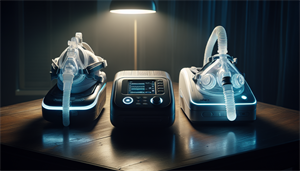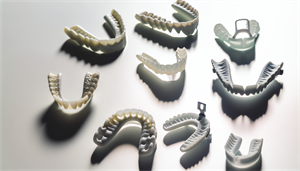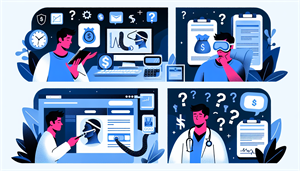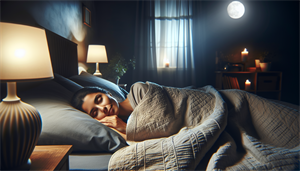Obstructive sleep apnea is a common yet potentially serious sleep disorder that interrupts your breathing during sleep. The consequences can range from daytime fatigue and morning headaches to more severe health problems like heart disease.
Fortunately, a variety of sleep apnea devices have been designed to manage this condition effectively. From Positive Airway Pressure (PAP) machines to oral appliances and positional aids, these treatment options can significantly improve your quality of sleep and overall health.
Key Takeaways
-
Positive Airway Pressure (PAP) machines, including CPAP, BiPAP, and APAP, are central to sleep apnea treatment, differing in pressure delivery to cater to individual patient needs.
-
Oral appliances like mandibular advancement devices and tongue stabilizing devices offer alternatives to PAP machines, usually requiring custom fitting to ensure effectiveness.
-
Complementing device usage with lifestyle changes such as weight loss, avoiding alcohol, and regular exercise can enhance management of sleep apnea symptoms.
Exploring PAP Therapy Options

Positive Airway Pressure (PAP) machines have been found to be highly effective in treating sleep apnea. They work by delivering pressurized air into the airways, keeping them open during sleep and preventing apnea episodes. These machines come in different variations, each designed to cater to specific patient needs.
Choosing the appropriate PAP machine type significantly enhances comfort and the effectiveness of the treatment. Some common types of PAP machines include:
-
Continuous Positive Airway Pressure (CPAP) machines
-
Bi-level Positive Airway Pressure (BiPAP) machines
-
Auto-titrating Positive Airway Pressure (APAP) machines
Consult with your healthcare provider to determine which type of PAP machine is best for you.
The most common types of PAP machines include Continuous Positive Airway Pressure (CPAP), Bilevel Positive Airway Pressure (BiPAP), and Auto-adjusting Positive Airway Pressure (APAP) machines. Each offers unique features and benefits that make them suitable for different types of patients. Regardless of the machine type, a correctly fitting mask is key as it delivers the proper pressure level, enhancing both comfort and treatment effectiveness.
Understanding CPAP Machines
CPAP machines are widely used for managing sleep apnea. Many people find them to be an effective solution for improving their quality of sleep. They work by:
-
Drawing in room air
-
Filtering it
-
Pressurizing it
-
Delivering it to the user through a tube and mask
This continuous stream of air pressure keeps the airway open during sleep, preventing apnea episodes and improving the quality of sleep. The American Sleep Apnea Association recommends the use of CPAP machines as a primary treatment option for sleep apnea.
Despite the notable enhancements in sleep quality and health provided by CPAP machines, they may also induce some side effects. These can include:
-
Discomfort
-
Nosebleeds
-
Dry mouth
-
Skin irritation
-
Headaches
But don’t worry, most of these side effects are common during the initial phase of treatment and can be managed with the help of a healthcare provider.
The Benefits of BiPAP Machines
BiPAP machines represent an alternative PAP machine type for managing sleep apnea. Unlike CPAP machines that deliver a constant stream of air pressure, BiPAP machines provide two levels of air pressure: a higher level for inhalation and a lower level for exhalation. This dual pressure system can be more comfortable for patients, particularly those who have difficulty tolerating high CPAP pressures. As such, BiPAP machines may be a more suitable option for individuals with severe sleep apnea.
The focused approach of BiPAP machines results in effortless breathing and a more comfortable therapeutic experience. Their use is commonly recommended for patients with conditions such as lung disorders, cardiovascular disorders, or congestive heart failure, as they may require varying pressures during inhalation and exhalation.
Auto-Adjusting APAP Machines
Auto-adjusting Positive Airway Pressure (APAP) machines take PAP therapy a step further. These devices automatically adjust the air pressure throughout the night to meet the patient’s changing needs, ensuring optimal comfort and effective treatment for obstructive sleep apnea. Unlike CPAP and BiPAP machines that provide a constant or dual pressure respectively, APAP machines adapt the air pressure within a specified range to cater to the user’s requirements.
This ability to auto-adjust makes APAP machines a more personalized and convenient treatment option for sleep apnea.
Oral Appliance Solutions

For individuals who find PAP machines uncomfortable or inconvenient, oral appliances present an alternative solution. These devices are designed to maintain an open airway during sleep, often by addressing anatomical factors that contribute to sleep apnea, such as a lower jaw that moves backward or a tongue that falls back and obstructs the airway. There are two primary types of oral appliances: mandibular advancement devices, which maintain the forward position of the jaw, and tongue retaining devices, which secure the tongue in place to prevent airway obstruction.
While oral appliances may not be as consistently effective as CPAP therapy, they do offer greater ease of use. However, they require precise fitting to be effective. Hence, it’s necessary to consult a dental sleep medicine specialist to guarantee accurate appliance fitting and correct usage, optimizing its effectiveness.
Custom-Fit Mandibular Advancement Devices
Custom-fit mandibular advancement devices are personalized oral appliances designed to address sleep apnea. They work by positioning the lower jaw slightly forward during sleep, thus opening up the airway and relieving symptoms related to obstructive sleep apnea. These devices are often recommended for individuals who snore or experience mild to moderate sleep apnea.
Indeed, they can potentially completely relieve mild obstructive sleep apnea forms.
Tongue Stabilizing Devices
Another type of oral appliance used in the treatment of sleep apnea is the tongue stabilizing device. These devices function by maintaining the tongue in a forward position to prevent airway blockage, serving as the fundamental principle in the treatment of obstructive sleep apnea syndrome (OSAS). Studies have shown that they can enhance breathing by anteriorly positioning the tongue, consequently aiding in the management of sleep apnea symptoms.
However, there are compliance issues related to the use of these devices, which could impact their overall effectiveness.
Innovative Upper Airway Stimulation
In recent years, innovative technologies have been developed to address sleep apnea. One such technology is the upper airway stimulation device. These small devices use neurostimulation to maintain the openness of the airways. The Inspire Upper Airway Stimulation system, for instance, is a surgically implanted device that operates like a pacemaker, delivering targeted stimulation to the throat muscles to prevent airway collapse.
While preliminary research indicates that these implant systems could be effective in treating sleep apnea, the evidence regarding their long-term effectiveness is currently inconclusive. Additionally, it’s important to note that these devices may not always be covered by health insurance, potentially making this option financially challenging.
Positional Sleep Aids and Their Role
Positional sleep aids are another treatment option for sleep apnea that can be used alone or in combination with other devices. These aids promote side sleeping, a position that can alleviate symptoms of sleep apnea. Some of the devices used for positional therapy are the Zzoma pillow and the Night Shift Sleep Positioner. Another option is the Philips NightBalance Positional Sleep Therapy Device..
Studies suggest that these devices can effectively manage sleep apnea symptoms, reducing their impact on daily life.
Lifestyle Adjustments for Sleep Apnea Management

Alongside using devices, making lifestyle adjustments can also play a significant role in managing sleep apnea symptoms. Losing excess weight, for instance, can decrease the severity of sleep apnea symptoms. Abstaining from alcohol is also crucial as it can relax the throat muscles, thereby worsening sleep apnea symptoms.
Other strategies include maintaining healthy sleep habits, managing stress, quitting smoking, and participating in regular exercise.
Navigating Insurance and Costs for Sleep Apnea Devices

Comprehending insurance coverage and costs is key when contemplating sleep apnea devices. While most PAP machines are usually covered by insurance as they are considered medical equipment, the cost after insurance coverage can vary depending on the location and provider. Additional costs could encompass copays, follow-up appointments, and accessories.
Additionally, you may have to pay for an extra portable CPAP machine if you plan to use it for travel. This expense may not be covered by insurance.
Tips for Choosing the Right CPAP Mask
Selecting the most fitting CPAP mask is vital for achieving comfort and efficient treatment. There are different types of masks available, including full face masks, nasal masks, and nasal pillow masks, and finding the right one can enhance comfort and effectiveness in treatment. The size and shape of the mask play a crucial role in its functionality. An ill-fitting mask can lead to discomfort, skin irritation, and compromised treatment efficacy.
Materials used in the construction of CPAP masks that influence user comfort include:
-
Silicone
-
Gel
-
Foam
-
Synthetic neoprene
-
Soft fabrics like cotton, bamboo, and microfiber
-
Hard plastic (in some masks)
For individuals with facial hair, selecting a mask that offers a secure seal and comfort is crucial.
Care and Maintenance of Sleep Apnea Devices
Appropriate care and maintenance of sleep apnea devices are vital to guarantee their durability and efficiency. Masks should be cleaned with warm water and mild dish detergent, while headgear should be washed in soapy water, thoroughly rinsed, and then allowed to dry completely. Replacement of the mask, tubing, and/or filter on CPAP and BiPAP machines is also important, with guidelines usually recommending replacement every few months or every 6 months respectively.
For APAP machines, it’s recommended to soak the humidifier tub in a warm water and mild dishwashing liquid or vinegar solution weekly, and give the mask and tubing a full bath once a week.
Adapting to Life with a Sleep Apnea Device
Accustoming oneself to living with a sleep apnea device might require some time. Common challenges during the initial phase of using a sleep apnea device can include:
-
Mask leakage
-
Feeling claustrophobic
-
Uncomfortable mask fit
-
Excessive air pressure
The usual adjustment period for using a sleep apnea device is approximately 2 to 3 weeks, but following tips and guidance from healthcare providers can help ease this transition.
Once accustomed, a sleep apnea device, such as a CPAP machine, can enhance sleep routines by minimizing sleep interruptions often associated with sleep apnea.
When to Consult a Sleep Specialist
If your sleep apnea symptoms continue or intensify despite regular use of a sleep apnea device, you should consider consulting a sleep specialist. A sleep specialist can assess the effectiveness of your current treatment plan and suggest modifications to your therapy, which might involve suggesting alternative positive airway pressure therapy settings or exploring other treatment options.
Summary
Treating sleep apnea is essential for your health and quality of life. From PAP machines like CPAP, BiPAP, and APAP, to oral appliances and positional aids, several options can help manage sleep apnea symptoms effectively. Lifestyle adjustments, such as weight loss and reducing alcohol consumption, can also contribute to symptom management. Understanding insurance coverage and costs, as well as properly caring for and maintaining your sleep apnea device, can ensure its longevity and effectiveness. If your symptoms persist or worsen, consulting a sleep specialist is recommended. With the right device and treatment plan, you can achieve better sleep and improved health.
Frequently Asked Questions
What is the new device used for sleep apnea?
The new device used for sleep apnea is the Inspire® implant, which is the only FDA-approved OSA therapy that works inside the body to treat the root cause of sleep apnea, eliminating the need for a mask or hose.
Is there an alternative to a CPAP machine?
Yes, alternatives to CPAP machines include other PAP devices such as BiPAP or ASV machines, as well as implantable nerve stimulation or lifestyle changes like weight loss and exercise. It is important to consult with a healthcare professional to determine the best alternative for your specific condition.
What is inspire?
Inspire therapy is an implantable treatment for obstructive sleep apnea in individuals who are unable to use or benefit from continuous positive airway pressure. It is an option for those with moderate to severe obstructive sleep apnea with a specific apnea-hypopnea index.
What are some common types of PAP machines used to treat sleep apnea?
Common types of PAP machines used to treat sleep apnea include CPAP, BiPAP, and APAP machines, each with unique features and benefits tailored to different patient needs.
What are oral appliances, and how do they help treat sleep apnea?
Oral appliances are devices that help treat sleep apnea by maintaining an open airway during sleep, typically by addressing anatomical factors contributing to the condition. They are designed to prevent the lower jaw from moving backward or the tongue from falling back and obstructing the airway.


